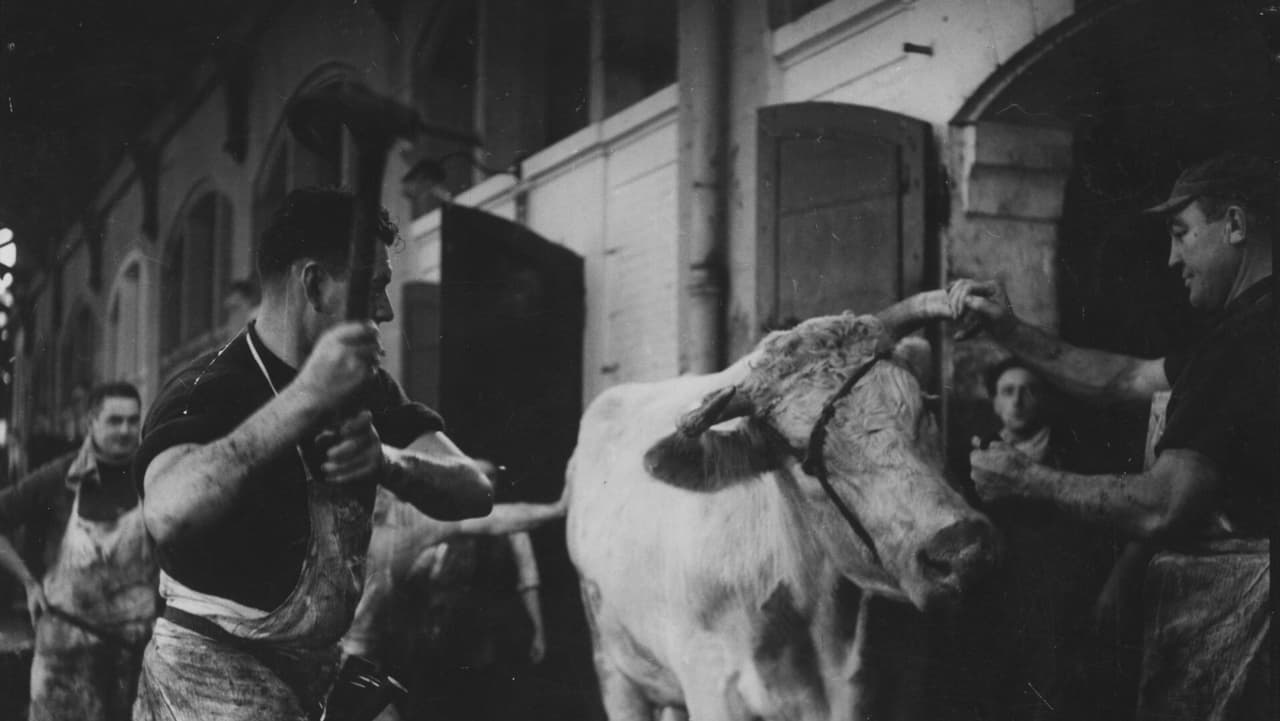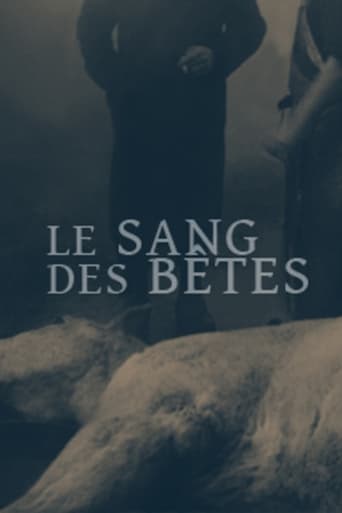StunnaKrypto
Self-important, over-dramatic, uninspired.
Exoticalot
People are voting emotionally.
Dynamixor
The performances transcend the film's tropes, grounding it in characters that feel more complete than this subgenre often produces.
framptonhollis
Now, other people seem to find this to be a GREAT film, a MASTERPIECE, but I don't necessarily find it to be either of those things. That doesn't mean I found it to be bad, it was a quite interesting documentary short, that did genuinely disturbed me.It is a very simple premise, it is just footage that was shot inside a slaughterhouse, with some narration. It is very fascinating, although highly unsettling, although it didn't really change my life. As I said, I was highly disturbed throughout the film, and for a good purpose, but it didn't make me become a vegetarian or a vegan. I guess at this point I'll never become a vegetarian/vegan.However, just because I'm not a vegetarian/vegan doesn't mean that it won't make YOU possibly think of becoming one! I can fully understand why someone would be affected by the horrific imagery in this documentary film would start thinking way more about what they eat and how it's made.
Pierre Radulescu
There is a catharsis brought by art works that are painful to watch. In this case the catharsis does not come immediately. It takes time to sublimate the horrible experience, to get beyond it and to understand. To really understand.A 20 minute documentary made in 1949 by Georges Franju (and scored by Joseph Kosma), calmly depicting the everyday work in the abattoirs from the outskirts of Paris. The animals coming here with serenity, suddenly killed and, that's it, immediately skin and legs and head are apart, it all happens incredibly fast. Sometimes bits of life go on for a few seconds. It's horrible. The slaughters make this matter-of-factly, otherwise you cannot resist there.And as soon as you leave the slaughterhouse, it's normal life, that quiet poetry of normal life: sun, sometimes clouds, whisks of grass here and there, some debris, a pair of young lovers.And actually it's about death, about our death: we are always dying innocently, and death is just part of life: death is just that, matter-of-fact.
Ilpo Hirvonen
Together with Henri Langlois, Georges Franju was one of the founders of the legendary Cinematheque Francaise but his own, compact, production is still quite unknown. He is best known for his later feature, often categorized as a horror film, Eyes Without a Face (1960). His features were outstanding, masterful and brilliant but his earlier short documentaries might be even greater. The hard world was the subject in all of his documentaries; he depicted a world, without illusions, which was not better at all after the war it had just went through - WWII. In these documentaries he dealt with the truths behind human monuments (Hotel des invalides), the misuse of good intentions and accomplishments. Two of these documentaries stand out, and are his most well known ones: Hotel des invalides which was a pacifistic reportage of a war museum and Le sang des betes; a documentary about a slaughterhouse in Paris.It would be juvenile to see Le sang des betes as a film about animal cruelty, or even as a moral study. Of course, one might say that watching it is the first step taken towards vegetarianism but to my mind there is much more in it, and I am a vegan. Le sang des betes depicts man deforming nature into something obnoxious. It's a poetically realistic film, filled with fantastic and grotesque details, where actual sights characterized by tragicalness.The film is ultra-realism but also dream-like. It's in the same area with Luis Bunuel's "documentary" Las Hurdes - A Land without Bread; a film so honest that its realism turns into surrealism. In Le sang des betes Franju gave reality an artificial expression; he created a natural environment which turned into a setting - the contrast of the slaughterhouse and the outside world. The material world of the film reinforces this idea: old furniture thrown away, flee market, drying sheets and surrealistic details such as a mannequin, painting (Renoir?), umbrella and children playing outside.Before we are taken to the harsh reality of the slaughterhouse Franju depicts the world outside; people falling in love, children having fun, city sights and life passing by. Then we are taken away from this, through a brilliant poetic shift; a woman gets kissed and a fan goes through the picture as we are taken to the slaughterhouse. This surreal, poetic detail is very important; from the touch of kiss to the slaughterhouse through a dream-like shift - there is also a slaughterhouse.The irony in the commentary tracks is not juvenile agitation and doesn't rank in the simple level of anarchism. Georges Franju had the same intensity of tenderness that many great filmmakers have; for instance the earlier mentioned Luis Bunuel. He had the courage to show violence without beautifying it one bit. The introduction of the used equipment; killing machinery, is honest and realistic.There is no quarrel about the film's obvious allegory. The victims of the following day are already known; a strong metaphor to the holocaust of which four years had just passed. In the end we see the gates of the slaughterhouse closing, or are they just the same gates of Auschwitz we've seen in so many pictures? The film is both poetic and realistic, dream-like and genuine, timeless and strongly historical.
Polaris_DiB
This movie is slightly infamous for being the type of movie that makes people want to swear off meat--I can't say I relate to this reaction, as I don't understand where people think their meat came from in the first place if not from situations like this. However, Franju is a surrealist and a poet, and there are indeed methods of real horror induced here. The thing is, the movie is so much more interesting on the material level than on the thematic.Honestly, Franju's narrative "voice", if you'd call it that, is largely ambivalent. Franju records the destruction of the animals from living beasts we recognize in fields almost every step of the way to the packaged bits we buy at a supermarket. Along the way, he notes the personalities of the people in the slaughter house and notes the proximity to the "civilized" world outside (a slightly over-done montage of set pieces and poses). Love, logic, and creativity go on while literal "whole-sale slaughter" and destruction happens right across the river. This movie shares a lot with "Nuit et Brouillard" in that respect.However, what's more fascinating is the materiality of the beasts: the patterns left behind on their meat when the skin is stripped away, the separate parts removed, muscle, sinew, and bone. Seeing this movie is seeing organic life as almost an object with shared characteristics of furniture: frames, stuffing, and fluff. In black and white cinematography, blood runs like water, and the two are analogous to each other. Even the unconscious spasms of the dead animals become something of a physics event, an equal and opposite reaction--which can be highly disturbing at the same time as it is honestly beautiful.--PolarisDiB

